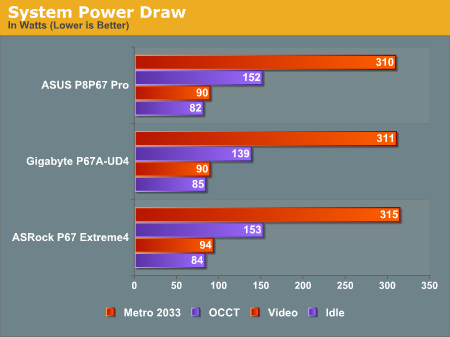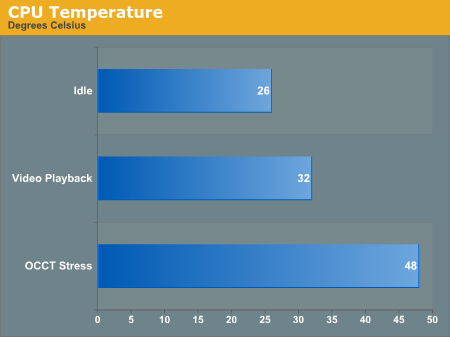Welcome to Sandy Bridge, with the ASRock P67 Extreme4
by Ian Cutress on January 3, 2011 7:00 AM EST- Posted in
- Motherboards
- ASRock
Overclocking
Overclocking on Sandy Bridge is significantly easier than on previous platforms. With only the multiplier to play with, it is a case of finding the correct balance of multiplier and voltage.
Using the AXTU software bundled with the motherboard, I simply pushed the multiplier up to 44x (4.4GHz) without any issues. At this speed, the CPU would declock to 4.0GHz when OCCT was running, indicating that we were hitting the power draw limit automatically determined by the motherboard. On 4.5GHz, the system would BSOD when starting the OCCT stress tool, indicating that not enough voltage was being supplied to the processor.
In the UEFI, due to the auto overclocking settings offered, I set the system to boot at 4.6GHz. In the OS, this set a voltage of 1.378V, and ran an OCCT stress test fine, showing a maximum temperature of 70ºC (Idle 37ºC). At the 4.8GHz setting, we got 1.49V through the processor, but a failed OCCT stress test. On the next boot, I had to reset the UEFI to get it to stay stable while changing settings.
In my wisdom, and by delving into the UEFI settings, I ventured forth to manipulate the multiplier and voltages personally. I booted into Win7 with 4.5GHz, 1.4V on VCore and 1.9V on CPU PLL (for some headroom), and turned off Load Line Calibration. However, the OCCT stress test also resulted in the CPU declocking automatically. In order to get this to stop, I had to turn on Intel SpeedStep, and increase the Long Duration Power Limit from 95W to 110W. With this, I hit 4.6GHz and 4.7GHz (hitting 73 ºC, and reducing to 4.6GHz so I increased the power to 120W). For 4.8GHz, I pushed VCore to 1.45V, and the power limits to 150W (short) and 130W (long)—this gave a stable OCCT at 80ºC but would randomly BSOD. At these settings, 4.9GHz would not boot into the OS, and I was not willing to push them further.
4.6GHz using the UEFI settings seems like the best bet for any user wanting a simple 24/7 overclock. The 3D Movement multithreaded benchmark rose from a stock score of 341.74 to 451.84.
Power Consumption and CPU Temperatures
Power consumption was tested on the system as a whole with a wall meter connected to the power supply, using a dual GPU configuration. This method allows us to compare the power management of the UEFI and the board to supply components with power under load, and includes typical PSU losses due to efficiency. These are the real world values that consumers may expect from a typical system (minus the monitor) using this motherboard.


The Extreme4 doesn't do too badly in power consumption readings compared to the other boards. It ends up slighly higher under heavy loads, but the differences are small enough that we can't see power requirements being a selling point one way or another yet.










55 Comments
View All Comments
Mazlov - Tuesday, January 4, 2011 - link
Having read all the SB articles on AT, I must admit that I too feel that this platform is getting a bit more attention than it deserves. I suspect this is because X58 has been around for such a long time, and enthousiasts are eag to get their hands on something new.In reality, SB, although providing us with a very decent performance upgrade, is not all that exciting. IPC does not seem to have improved very much. Much of the improvement seems to be realized by the higher stock clocks and excellent Turbo. Both of which are a direct result of the new 32nm production process.
The thing that realy bothers me though, is that the chipsets look as if it's still 2009. With the exception of sata-600, nothing about the SB platform is particularly modern. No onboard usb3, not a trace of Light Peak (while Apple is rumoured to have it on Macs this year), no pci-e 3.0 (understandable since it has only rercently been finalized). Looks to me as if Intel is indeed hostage of their own time schedule.
To make matters even worse. Intel has taken their market segmentation one step further, by increasing the amount of different chipsets. All with their own limitations.
Now I'm not saying that SB is a bad product. For over ninety percent of consumers it will fit perfectly. Whether it is good enough for us enthousiasts... I doubt it. 2011 will see some interesting new technologies and SB sadly does not seem to support them yet. If you are a hardware enthousiast, unless you are willing to upgrade again at the end of this year, SB is not for you.
mapesdhs - Wednesday, January 5, 2011 - link
Two 8X PCIE is more than sufficient for SLI/CF with the vast majority of games/apps
using anything other than perhaps the highest end GPUs. naturally X58 favours 3-way/4-way CF/SLI, but few games benefit significantly from these modes (to the
extent that the entire additional platforum cost is worthwhile) and some games perform
worse.
Likewise, dual-channel RAM is also plenty, especially since unlike X58 the
P55 platform does not suffer from the 'vanishing' RAM channel problem when overclocking.
However, I do agree that X58 is hardly dead for those who've bought them. Very
few users will really *need* the extra speed offered by SNB CPUs, and all those
with 920/930 CPUs have the 6-core options which will come down in price.
But don't claim that dual 16X PCIE and 3-channel RAM is essential for high
performance because that's just plain wrong. With the help of a friend who has
an i7 930 system with two GTX 460 SLI, I've accumulated a plethora of benchmark
results which show what I mean (my system is an i7 870 @ 4270MHz, dual EVGA
GTX 460 1GB FTW SLI). Google for "3DMark06 Benchmark SGI Depot", see the
end of the page for the URLs of the other _nine_ pages of performance results,
more added daily/weekly when I & my friend are able.
QED.
Ian.
jp9700 - Monday, January 3, 2011 - link
I just wanted to thank you for including your "3D Movement" benchmark. I do a fair amount of computational chemistry myself (although generally quantum mechanics), and I find it incredibly hard to find applicable benchmarks on new hardware.jimhsu - Monday, January 3, 2011 - link
Seconded ... most of the scientific community is notoriously conservative when it comes to publishing relevant benchmarks for scientific applications on new hardware. Often, the best you can do is hear from a colleague that "Lab X upgraded to Y and got good results" or "Dr. A. (who published in Nature, Cell, Science, whatever) has 10K in grant money and bought that, so we should too". On rare cases you might see an anecdotal report on a group's public website that tests a single config against another particular configuration and shows a % improvement ... those are rare though.DesktopMan - Monday, January 3, 2011 - link
When are they getting rid of the Realtek hardware? The Realtek audio drivers have given me nothing but trouble for years. Isn't there support for gbit ethernet in the platform as well, but board manufacturers choose not to use them? Remember reading about that last bit but not entirely sure if I remember correctly.wolfman3k5 - Monday, January 3, 2011 - link
When something CHEAPER and BETTER will come along. And if you're complaining about Realtek, well, do you remember the old audio codecs that where used in the past before Realtek?dgobe - Monday, January 3, 2011 - link
It would be nice to see an i7 920(OC'd) vs an i7 2600K at the same clock speed. Turbo off, just to see how the two architectures compare.wolfman3k5 - Monday, January 3, 2011 - link
You won't see that because the idea is to throw out the old and buy new. Line your pockets people, in a couple of days you'll be able to buy shiny new toys at newegg.com. As for everyone else, keep and eye on eBay for tons of cheap used CPUs and Mobos.landerf - Monday, January 3, 2011 - link
About the bandwidth (muti 3d test), while clock for clock yes 1155 only beats 1156, at max speed it should pass or match 1366 as 1366 is speed limited. That's why I bought 8 gbs of 2400mhz ram in prep for sandy.GTVic - Monday, January 3, 2011 - link
I've seen very little information on UEFI, do some Sandy Bridge motherboards have a BIOS or do they all have UEFI.Also, this motherboard has two PS2 ports and a floppy connector. I have seen several Sandy Bridge motherboards which have no IDE, no floppy, no serial/parallel ports and only one blue/green PS2 port. So this motherboard seems to be catering to people with legacy requirements. I think the need for a floppy connector is overstated.